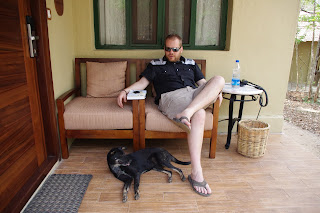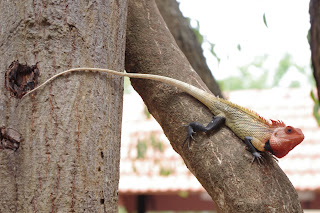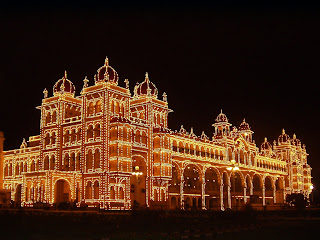The Isles of Scilly is a vacation destination renowned in the UK for its beauty and wildlife, but I had never heard of it until I met my husband. He, along with other biologists at the University of Exeter, takes undergraduate biology students there each spring so they can learn about ecosystems and diversity and just generally experience wildlife in their natural habitats. For the past two years I have been lucky enough to tag along and I am finally beginning to learn how to identify enough animals and plants that I feel somewhat useful as an instructor. Last year I either failed to take my camera or just never used it; luckily I had it on hand this year, when the expedition was even more photogenic thanks to five solid days of perfect weather.
The trip started in Penzance, from which we took a ferry, the Scillonian III, to the main island, St. Mary's. The trip is only 45 km (28 miles), but it takes about 2.5 hours. If you have more than just a carry-on, which all of us did, you put your luggage in a cargo container that is loaded onto the ship by a crane on the front deck. Pets are welcome, and usually abound; I am always impressed by the calmness with which the dogs survey their noisy, vibrating, diesel-smelling surroundings. No matter how warm the air and how sunny the sky, the trip is inevitably chilly. This year it was much more pleasant than last year, when it was very overcast and even a bit drizzly. Still, I was shivering despite wearing a t-shirt, a thermal long-sleeve shirt, a hooded sweatshirt, and a thick windbreaker. One day I will find the right combination of clothing to make the trip more bearable. Luckily there is a cafeteria on board, so you can frequently stock up on hot cups of tea.
You can sit inside if you wish, but then you will miss the wildlife sightings that inevitably occur during the journey. Although it is possible to see porpoises, dolphins, whales, and sunfish, I have only ever had any luck with finding birds--storm-petrels, shearwaters, gannets, cormorants, shags, kittiwakes, gulls, and even a few of the auks that the Isles of Scilly are famous for. These are much more common in the Isles than elsewhere in Cornwall, but can be seen along some of the crags near Land's End at the beginning of the journey. Though the puffin is the most common symbol found on Scilly tourist merchandise, the real source of avian excitement is all the migratory birds that land on the islands during the spring, but particularly the autumn, migration. These include birds that have overshot their destinations in the spring and need to rest up before heading back down to France and Spain, those that are on their way south to Africa after breeding during in the Arctic during its short summer, and even North American individuals that have been blown seriously off-course by heavy winds. Among "twitchers," list-crazy birders who traipse all over the country in order to see as many species as possible each year, the Scillies are an essential destination in order to view the real rarities. Last year, we stumbled upon a (relatively uncommon) short-toed lark wandering around the island of Gugh; this year, in the same location, we tried but failed to find a tawny pipit. Both birds were "overshoots," who would eventually turn around and go back south to their appropriate breeding grounds (at least, we hope).
The decks of the Scillonian are also a good place to just generally enjoy the dramatic Cornish scenery:

Like the rest of Britain, the various islands and islets of Scilly (5 main islands, but several hundred land masses overall, depending on your counting criteria) are composed of granite produced by serious volcanic activity several hundred million years ago. The Scillies are considered by many to be the most dangerous maritime habitat in Britain thanks to its jagged rocks and ledges that sit just under the waves; there are anywhere from 800-2000+ wrecks sunk around the islands. The rocks are particularly dangerous because they are not only unseen, but unexpected--the Scillies rest on a plateau that drops off quite suddenly into deep ocean, so unwary sailors may not realize until too late that they have crossed the divide between safe open water and dangerous continental shelf. The harsh winds near the Scillies add another element of danger; many claim that this is also the most exposed location in Britain.
The Isles of Scilly have not always been as isolated as they are now; many thousands of years ago--and as recently as 4,000 years ago--sea level was low enough that Scilly could be reached by foot from the mainland. In fact, it is still possible to walk between some of the islands at low tide--particularly during the spring. Some of the Isles were even covered by glaciation during the last ice age; one Scilly guidebook (The Secret Nature of the Isles of Scilly, by Andrew Cooper) urges visitors to stand on one of the lookout points on St. Mary's and imagine the massive cliff of ice that would have been visible approximately 20,000 years ago. Since the ice melted, all of Britain has been sinking steadily in a process known as "post-glacial rebound." In the Scillies, this loss of height has been compounded by the wearing action of the wind and waves. All told, however, the islands are shrinking at a negligible rate--it is nothing for the next couple of generations to worry about quite yet, barring any additional, unexpected, geological activity.
Our field course set up camp at The Garrison, site of a castle and fortification originally built in the 16th century following the Spanish Armada of 1558. Unfortunately, we were not staying in the castle, which is now home to a hotel called The Star, but in the campsite above the Garrison walls.
 The nice thing about the campsite is that many of the animals there are quite tame, so we could get great views of the song thrushes and blackbirds, in particular; this year I even got a female blackbird to eat right out of my hand. Last year I saw my first-ever hedgehog in the campsite, and we got another good look at one this year. Unfortunately, because they are nocturnal, I was not able to get any good photos.
The nice thing about the campsite is that many of the animals there are quite tame, so we could get great views of the song thrushes and blackbirds, in particular; this year I even got a female blackbird to eat right out of my hand. Last year I saw my first-ever hedgehog in the campsite, and we got another good look at one this year. Unfortunately, because they are nocturnal, I was not able to get any good photos. (Male blackbird with the characteristic bright orange Scilly bill; mainland blackbirds have more golden bills. Scientists still haven't figured out what causes this difference.)
(Male blackbird with the characteristic bright orange Scilly bill; mainland blackbirds have more golden bills. Scientists still haven't figured out what causes this difference.)According to the last census, approximately 2,200 people live in the Isles of Scilly; most of these inhabit St. Mary's, which is the biggest island. Our field course takes place at the very beginning of the tourist season. The weekend after we depart, the Isles host the World Pilot Gig Championships, which (I am told, but have not personally seen) brings in a massive crowd of participants and observers alike. I cannot imagine how the town copes with all these additional people, because just our group of 30-odd individuals depleted stocks in the grocery store (particularly on the evening that we treated the students to a barbecue) and made all the delis, pubs, and other eating facilities quite cramped at mealtime. This year we happened to be on the islands during Easter weekend, as well as during the weekday when cruises stop by to let travelers spend an afternoon on the islands. I am not entirely sure what all these people usually do when they visit Scilly, but shopping appears to be high on the priority list. Insanely, there are also a good number of people who sit on the beach and try to get tan; some even wander into the water. Given how uncomfortably cool it is even at the height of summer on the relatively less exposed mainland Cornish beaches, I cannot imagine how unpleasant these activities must be.
In my humble opinion, the only way to fully enjoy the Isles of Scilly is to explore them, a process that requires both good walking shoes and a boat. During our stay, we hiked around the circumference of St. Mary's (approximately 5 miles), which only takes a couple of hours but gives you plenty of opportunities to catch amazing views of the water, the geology, the flora, the fauna, and some of the lovely local cafes selling fresh-baked goodies and Cornish ice cream.
You will also pass several places of cultural interest, such as studios selling local art and historic buildings and cemeteries.
The islands have been inhabited since the Neolithic (4500-2200 BC), evidence of which is provided by many megaliths, menhirs, and stone circles that can be found dotting various islands. Our hike around Gugh took us near both a standing stone and an old, excavated, burial chamber called Obadiah's Barrow. Interestingly, though this one dates to the Neolithic, it was reused during the Bronze Age, as evidenced by the mixture of standing-stone and horizontal top-stone architecture. Sadly, none of its standing stones are still actually standing, the last having been intentionally knocked over during the Victorian times in order to prevent its accidentally falling on top of a passer-by (the British obsession with health and safety obviously has a long and illustrious history). There would be many more such similar sites if the stones didn't make such attractive building materials; modern inhabitants have relocated many of them for use in walls and foundations.
As I hinted at earlier, Scilly has a wide variety of wildlife that is special in one way or another. This includes not only the migrants that pass through at various times of the year--not just birds, but also moths and butterflies on land, and whales and turtles in the water--but also full-time residents. Scilly is a strange mixture of "native" and "introduced" species, though how exactly you draw the line between them at this point is anybody's guess, given how many things have naturalized over the years. Over the years, a variety of plants and animals have found their way to the islands through intentional introduction (particularly to the gardens on Tresco) and also by some mixture of accident and luck (for instance, stick bugs established a population after hitching a ride on some of the introduced plants). For a while, the main source of income in the Isles was flower farming, since the (relatively) extreme southern latitude meant that Scillonian farmers could beat their mainland competitors to the punch each season. Daffodils were a particularly big crop, though several other species were also popular. Several varieties of each species are Scillonian specialties, found nowhere else. However, though you still run across many of these flowers growing in farm fields and wherever else they manage to put down roots, this livelihood is no longer as important to the local economy as it used to be.
Other than the "true-" and "now-native" plants, there are many escapee "invasives" growing rampant across the island--in particular, the South African hottentot fig (the quotation marks indicate how difficult it is to distinguish between these three categories, given that all three were, at some point or another, an "invasive"). The fig may not be ideal for the local ecosystem, but at least it is attractive.
 (The bright green plant with the yellow flower is the hottentot fig; the more spindly, silvery-green plant growing amongst it is rock samphire, an edible plant that must be used sparingly in dishes because it is so salty.)
(The bright green plant with the yellow flower is the hottentot fig; the more spindly, silvery-green plant growing amongst it is rock samphire, an edible plant that must be used sparingly in dishes because it is so salty.) (Native bluebells growing on Scilly. They are smaller, have a deeper purple color, have a more closed and rounded bell shape, and the flowers all tend to hang to the same side of the stem.)
(Native bluebells growing on Scilly. They are smaller, have a deeper purple color, have a more closed and rounded bell shape, and the flowers all tend to hang to the same side of the stem.) (Another local specialty is the sea holly, which we routinely find on Gugh and St. Agnes, but which does not thrive as much elsewhere. This particular bit of growth managed to survive a hurricane, popping back up out of the sand several weeks after the storm.)
(Another local specialty is the sea holly, which we routinely find on Gugh and St. Agnes, but which does not thrive as much elsewhere. This particular bit of growth managed to survive a hurricane, popping back up out of the sand several weeks after the storm.) (A lone puffin, the only one brave enough to sit near our boat after the rest of its flock took off.)
(A lone puffin, the only one brave enough to sit near our boat after the rest of its flock took off.) (Mostly guillemots, but also a razorbill or two. The Guillemots are the ones that are browner and have more delicate bills; the razorbills are blacker and have a thicker bill with a white stripe.)
(Mostly guillemots, but also a razorbill or two. The Guillemots are the ones that are browner and have more delicate bills; the razorbills are blacker and have a thicker bill with a white stripe.)Although it is easy to get distracted by the plants and animals, which are in such obvious and colorful abundance, it is important to note that Scilly also offers ample opportunities to enjoy special insects, such as the oil beetle, the indigenous Scilly bee, and some very rare species of Scillonian ant, as well as a prodigious amount of sea life. Fossicking (or rock-pooling), that beloved British pastime, can be conducted at numerous locations around the island, yielding a variety of crabs, fish, mollusks, invertebrates, and algae. Unfortunately, none of these species is very easy to photograph once you've stuck it in a bucket of seawater to keep it happy while you examine it up close, so all I've got is a photograph of a very promising-looking pool waiting to be investigated.

 (There are also some interesting bits of flotsam and jetsam. A few years ago a container ship wrecked in Scilly and for the next few weeks, islanders were able to pick up free samples of tobacco and superhero costumes, among other things, after they'd washed up on shore.)
(There are also some interesting bits of flotsam and jetsam. A few years ago a container ship wrecked in Scilly and for the next few weeks, islanders were able to pick up free samples of tobacco and superhero costumes, among other things, after they'd washed up on shore.)The Isles were stunning during our overwhelmingly sunny visit this year, and still quite attractive during our previous trip when it was cloudy most of the time. There is actually little variation in air temperature throughout the year--less so even than in mainland Cornwall, which is milder than the rest of the UK--but the unpredictable sea breezes make a huge difference. Depending on their strength and the direction from which they are blowing, they can either be pleasant or really, really painful. The key to enjoying your stay on the Scillies is to pack for every contingency--thermals, sweaters, and waterproofs are essential even when you go in the middle of summer. A hat and sunglasses are also necessary, since you'll get glare from above when on land, and below when on water. Because the paths can be quite rocky and very steep, it is important to have good, sturdy shoes; my well-worn hiking boots are, shall we say, on their last legs, and walking became a bit painful both for my feet and my knees. The most important pieces of equipment are binoculars and a camera, because this is a place where you will want to see far and wide, then document it so you can enjoy it again later.































